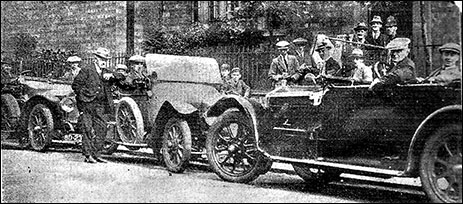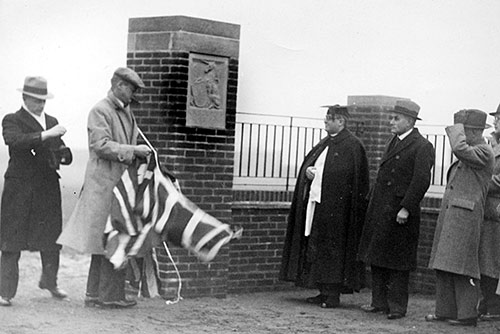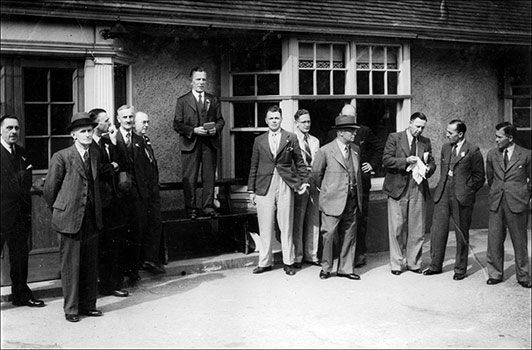| Summary researched and compiled by John Meads | ||||||||
|
||||||||
|
The town’s progress was halted by the First World War, which had a devastating effect on the working population. The population in 1914 was about 3,500. Of this number approximately 1,390 were men of military age but many would have been unfit to serve or key workers in reserved occupations. The 1917 Roll of Honour showed that up to that time 505 men served in the war. This is probably about 40% of the eligible male population. Of these 102 lost their lives, which means that 20% of those that went away did not return. Of those that did return, many were disabled and some never worked again. The War Memorial, which was unveiled in 1922, gives their names and also contains the names of 23 men and one woman who died during the Second World War.
Between the Wars After the First World War brick making had ceased and there was a sudden decline in the ironstone industry but the clothing and shoe factories recovered and continued to expand. It could be said that these two industries actually prospered during the war when production was switched to uniforms and army boots. Burton Latimer officially became a town in 1923 when it was constituted an ‘
Amenities between the Wars
A privately run public swimming pool opened in 1930 in Polwell Lane and in 1937 the council laid a road between Pioneer Avenue and William Street, which allowed the development of a recreation ground. The field had been used for many years for holding sporting and carnival events with access from
There were several other tennis courts around the town - behind George Mason’s garage, at the Ideal and Kaycee clothing factories and numerous private courts in the gardens of some of the larger houses. These would have been used by Burton Latimer Tennis Club, which was established in the early 1920s. Although the corrugated iron Constitutional Hall had closed, a timber-built public hall, The Pavilion, was built behind the shops (now occupied by Arthur Turner Ltd. and others) opposite the Red Cow and there were several other places that offered facilities for entertainment in addition to the Electric Palace Cinema and rooms in working-men’s clubs. The Baptist Assembly Room had been used for all sorts of events since it was built in 1886 and the long established Preston Hall was always in demand; but there were also the Co-op Hall, British Legion Hall, Conservative Club and the band room in Alexandra Street to cater for the social events that were a feature of life in Burton Latimer before television arrived. Although the town lost its purpose-built billiard room when the Coffee House closed, the band room in Alexandra Street became a billiard hall and many of the other halls had billiard tables, which were well patronised. Burton Latimer Bowls Club was formed in 1934 and played on a green behind the Conservative Club. The Britannia Club and the Finedon Street Working Men’s Club (The Rack) had clay quoits beds and had teams in a town league in the 1920s, so there must have been others. There were several long-established football clubs playing on pitches on the outskirts of the town: One seasonal sport, ice skating, was popular in the days when winters were harsher than those we experience now. Skating took place in the frozen flooded meadows near the river Ise and hundreds of people would flock to make the most of the conditions that often lasted for several weeks.
The Second World War Though thankfully not to the same extent as 25 years earlier, the Second World War brought more heartache to many Burton Latimer families and 24 more names were added to the War Memorial. Many families with children were evacuated here from Essex and Burton Wold was used by the army as a tank training area and army units were stationed in the town and surrounding area. The Inns of Court Regiment was first to arrive in 1941 and was followed by the Duke of Wellington’s Regiment and later, a unit of the Independent Czechoslovakian Armoured Brigade. A tank park and workshop was constructed at Wallis’s farm in
After the War When incendiary bomb making ceased in 1944 the Sterling Metals factory became Alumasc Ltd. and the aircraft repair factory was eventually purchased by Weetabix Ltd. for use as its transport depot. Council house building started again in 1945 and a number of un-repatriated German prisoners of war were employed during the building of the Spinney Road Estate.
Before the outbreak of war, Burton Latimer Urban District Council had been looking for new offices, but when a suitable property, The Poplars, became empty after the death of Mrs Ada Preston in 1941 they were unable to purchase it because of war time local government financial constraints. However, a long serving member of the council, Councillor A.G. Miller, bought the building and it was used by the council until constraints were lifted and the council were able to purchase it from Mr. Miller for the same price as he bought it. The building also contained the food office, where the rationing schemes were administered, and the town’s library. Since local government reorganisation in 1974, the building has been owned by Kettering Borough Council and now has some commercial use; a Borough Council rent and rates collection office, the council chamber and office used by Burton Latimer Town Council and the |
||||||||


